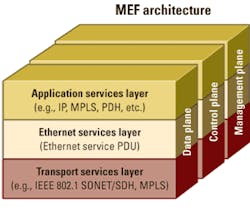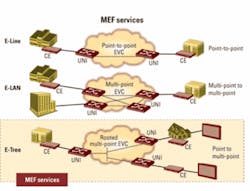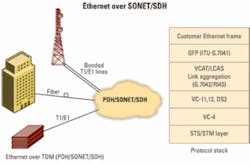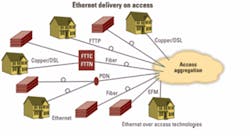by Morteza Ghodrat
Flourishing IP services in consumer and enterprise markets have created substantial demand for IP connectivity at the customer premises. Ethernet is the most cost-effective way to deliver these IP services.
Carriers currently can select from among several options for bringing Ethernet to the consumer. The choice often depends on the transport technology available at the customer location (xDSL, PON, SONET/SDH, Ethernet, etc.). These connections are generally architected around the historical view that Ethernet is a LAN technology that requires additional layers/technologies for use in transport applications. Thus, carriers face the operational complexities associated with operating multiple layers of protocols, which limits their competitiveness in the marketplace.
Fortunately, with the advent of Carrier Ethernet for the access, aggregation, and core network, carriers are now able to operate Ethernet as a WAN technology. Carrier Ethernet removes layers of complexity from the network, thereby enabling service providers to more effectively meet customer demand.
Migration to Carrier Ethernet is the next major trend in networking; with it, Ethernet has all of the ingredients required to build and operate the network efficiently, both from the service level as well as the transport level perspectives. Ethernet is the preferred networking interface for the consumer. Ethernet is inherently friendly with IP, which increasingly is becoming the underlying paradigm to deliver all services to consumers (video, VoIP, storage, security, VPN, wireless, Internet, etc.).
The business case for Carrier Ethernet is also compelling. By removing multiple layers of protocols from hardware and software, Carrier Ethernet platforms can bring a significant cost saving to the carriers (in terms of both capital and operational expenditures). The simplified architecture also allows faster deployments and rapid development of new distributed applications.
Initiated by Metro Ethernet Forum (MEF), Carrier Ethernet is a concept built on the success of metro Ethernet to include worldwide services traversing national and global networks. In the access network, this translates into the ability to support a much wider class of user over fiber, copper, cable, PON, and wireless. In the metro, aggregation, and core networks, the goal is to transport Ethernet services over existing technologies such as SONET/SDH, Optical Transport Network (OTN), and MPLS, as well as over the native Ethernet-based network.
The architecture of Carrier Ethernet enables movement of data from user-to-network interface (UNI) to UNI across "the network" with the layered architecture illustrated in Fig. 1.
When traffic moves between Ethernet domains it does so at the transport layer. This allows Carrier Ethernet traffic to be agnostic to the networks that it traverses. When traffic reaches the edge of a Carrier Ethernet network the data is transmitted to the user as its original Ethernet frames.
As shown in Fig. 2, services defined by Carrier Ethernet include
- E-Line, which is a point-to-point connectivity service designed to emulate private lines and virtual private lines;
- E-LAN, which is a multi-point-to-multi-point connectivity service designed to emulate LAN and virtual LAN over a WAN; and
- E-Tree, which is a point-to-multi-point connectivity service designed to emulate routed based service delivery architecture such as IPTV.
Carrier Ethernet offers several important attributes. For example, it supports the standardized services described above that can run over existing LANs and WANs, including those based on TDM. Scalability enables different levels of applications for business, information, communication, and entertainment. This applies to voice, video, and data and spans across access and metro networks, supporting a wide range of granularity of bandwidth and quality of service (QoS) options. Service management is the ability to monitor, diagnose, and centrally manage the network. It supports carrier-class operations, administration, and maintenance (OAM), and rapid service provisioning. Reliability enables the network to detect and recover from incidents without affecting customers. The reliability attributes also meet the most demanding availability requirements, such as 50-msec recovery. Finally, the aforementioned QoS includes a wide choice of granularity and options. This attribute enables carriers to meet their end-to-end service-level agreements for voice, video, and, data and provision end-to-end committed information rate, frame loss, delay, and delay variation.
The main vehicle for carriers to deliver services to large businesses and enterprise customers is the TDM network. With this architecture, the networking interface to the end customer is either native TDM (T1/E1/T3/E3/DS3/OC-3/OC-12/OC-48 -- with T1/E1 being the most common) or a multi-service provisioning platform (MSPP). With TDM, the end customer is required to have additional equipment for the protocol adaptation from Ethernet to TDM. An MSPP is a TDM platform that also handles the Ethernet protocol adaptations, making it easier for carriers to manage and deliver services to the end consumer at more attractive prices.
Generic Framing Procedure (GFP) is a popular encapsulation protocol for adapting Ethernet over SONET/SDH. The protocol is a generic octet-synchronous transport mechanism that maps protocol data units originated from client signals into a SONET/SDH virtual container (Fig. 3). GFP also supports link aggregation of n x T1/E1, allowing operators to offer more bandwidth to the consumer if the bandwidth for a single T1 or E1 is deemed insufficient.
There are several benefits realized with Ethernet over SONET/SDH. First, it enables carriers to offer Ethernet over their existing TDM infrastructure. Second, Ethernet is just another circuit that can be provisioned, maintained, and managed over the TDM network -- similar to other TDM services.
On the other hand, there are a number of drawbacks. The service turn-up is lengthy due to multiple layers of protocols that need to be configured, verified, maintained, and managed. Second, there is limited flexibility in the amount of bandwidth that can be offered, which usually ranges from 1-8 x T1/E1 (e.g., 5-12 Mbits/sec on T1). Third, lack of statistical multiplexing makes the Ethernet data service as expensive as a TDM service.
In the mass market, DSL and PON are the two most popular infrastructures with which carriers offer their best-effort IP services today (Fig. 4). DSL currently has the lion's share of the market; it leverages the existing carrier's copper plants (i.e., the phone network), and as result, it is less expensive to deploy than PON, which requires fiber buildouts.
Due to the nature of the protocol and the technologies used for encoding the signals, DSL is much more sensitive to distance than PON. For example, DSL performs poorly for distance beyond 15,000 ft. To get the benefit of both copper and fiber deployments, carriers often deploy technologies such as fiber-to-the-curb and fiber-to-the-node, which help them to overcome the distance limitation of DSL while reducing the cost of fiber buildout to every home/office in the last mile.
There are several variants of DSL that suit different customer needs and deployment scenarios. Asymmetric Digital Subscriber Line (ADSL) is the first generation of DSL technology designed to run over longer copper loops. With ADSL, a customer can receive up to 250 kbits/sec upstream and 1.5 Mbits/sec downstream. ADSL2+ offers bandwidth around 1 Mbit/sec upstream and 24 Mbits/sec on shorter loops (<10,000 ft), while VDSL2 can go as high as 3 Mbits/sec upstream and up to 100 Mbits/sec downstream on loops shorter than a few thousand feet.
There are also several flavors of PON. In North America and Western Europe the largest deployments of PON have used BPON (ITU G.893) technology. The BPON standard was created to enhance the older standard APON, which was primarily deployed for business applications. BPON adds support for WDM, dynamic and higher upstream bandwidth allocation, and survivability. BPON also supports a standard management interface, called ONT Management and Control Interface (OMCI), between the OLT and ONU/ONT, enabling mixed-vendor networks.
GPON (ITU G.984) is an evolution of the BPON standard. It supports higher rates, enhanced security, and a choice of Layer 2 protocol (ATM or Ethernet). Currently, Asia is in favor of EPON (IEEE 802.3ah) developed by the IEEE/EFM standard for using Ethernet for packet data. WDM-PON, DOCSIS PON, and RF PON (otherwise known as RF over glass) are other variants of PON being researched at the moment.
In addition to Ethernet over SONET/SDH, carriers have two other options to transport Ethernet in the core of the network: Ethernet over OTN (G.709) and Ethernet over MPLS.
Ethernet over OTN can be delivered in a few ways: Ethernet over SONET/SDH over OTN, Ethernet over GFP over OTN, and Ethernet over OTN. Ethernet over SONET/SDH over OTN enables carriers to leverage investments made on their transport infrastructures, tools, training, and other operational activities. On the other hand, when it comes to 10GbE transport, carriers prefer an Ethernet over OTU2 carrier like OTN, as it supports a high degree of QoS, and network management that carriers need to operate the network.
Ethernet over MPLS is a viable option to deliver Ethernet over packet-switched infrastructure. Support for oversubscription and multicast in addition to switching and bridging are the chief advantages realized with MPLS. It is important to point out that native MPLS is not a transport vehicle; thus if the link requires a transport component, additional layer(s) of transport need to be added (such as SONET/SDH and/or OTN). This in turn may add to the overall solution cost and increase the operational complexities required to manage the network.
MPLS Transport Profile (MPLS-TP), formerly known as Transport MPLS (T-MPLS), is another service delivery option suited for transport. Currently, the protocol is being defined within the ITU and IETF and is being specified for use as a network layer technology in transport networks. It follows the same architectural principal of layered networking used in SONET/SDH and OTN with a special focus on connection-oriented packet switching.
Today, ATM and Frame Relay are the two most popular protocols used primarily for data aggregation and grooming, and SONET/SDH is by far the vehicle of choice for TDM grooming and transport in the metro. Thus, for the time being, Ethernet over SONET/SDH will be the most realistic way to carry Ethernet in these environments. As previously noted above, Ethernet over SONET/SDH may be cost-prohibitive for handling large-scale Ethernet pipes in the MAN.
Going forward, there are several options for carrying Ethernet in aggregation and transport networks:
- Ethernet over OTN will enjoy the same benefits described above. However, there is a cost to extend (or deploy) OTN to the metro;
- Extending MPLS to the data aggregation network will certainly reduce the complexity and the overhead involved with ATM and Frame Relay-based approaches. MPLS also provides a more seamless migration from the metro to the core. Interoperability between the metro and core is another benefit. But extending native MPLS to the metro and the aggregation network may be cost-prohibitive. It is too early to tell if MPLS-TP can resolve this issue.
- Provider Backbone Bridge (PBB) and PBB Traffic Engineering (PBB-TE) are two other low-cost options supported by Carrier Ethernet for carriers who want to deploy Ethernet in the metro.
PBB (IEEE 802.1ah), known also as Mac-in-Mac, is designed to eliminate the scaling limitation of the current Q-Q (IEEE 802.1ad) implementation. Instead of 4,094 service instances in the metro (permitted by Q-Q), Mac-in-Mac supports over a million, making the protocol a viable option for transport.
PBB-TE (IEEE 802.1Qay) is based on PBB, but differs in that it eliminates flooding, dynamically created forwarding tables, and spanning tree protocols. Compared to PBB, PBB-TE behaves more predictably and its behavior can be more easily controlled by network operators. The architecture of PBB-TE allows for separation of the service layer from the transport layer. The key benefit realized is the ability to support hard QoS and protection schemes with 50-msec switchover at the transport layer without affecting the service layer. PBB-TE is also considered to be more scalable than PBB as it eliminates the need for MAC learning at the edge of the network.
Clearly, each option mentioned above has its own benefits and disadvantages. No one approach is best for all situations. However, for a Carrier Ethernet strategy to be successful, the following are key requirements that carriers should expect:
- Cost of the overall approach is a major factor when it comes to equipment deployed in the access and aggregation networks due to the large volumes expected;
- The approach must be scalable to support and aggregate tens of millions of traffic flows (and subscribers) in the network;
- QoS is very important to provide fairness for sharing network resources, especially with data traffic that is highly bursty; and
- Managing the network is critical for customer retention, increased revenue, and controlling operation expenses in an environment where services are added or removed on-the-fly.
Morteza Ghodrat is director of Carrier Ethernet technology at Vitesse Semiconductor.



